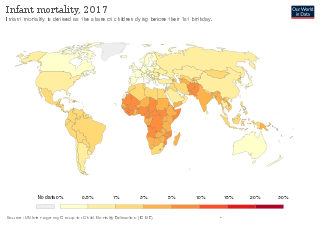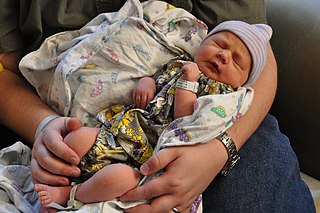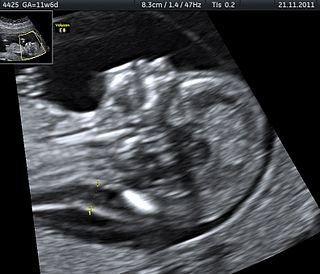This article needs additional citations for verification .(April 2016) |

Baby books are scrapbooks used by parents to track their children's development.
This article needs additional citations for verification .(April 2016) |

Baby books are scrapbooks used by parents to track their children's development.
Baby books first became popular over 100 years ago[ when? ] to keep track of children's diseases, immunization records, and growth. Baby books started appearing more frequently in homes in the 1910s but gained popularity in the succeeding decades. [1]
Baby books can track a child's development or mark developmental milestones. Many have ledgers that can track disease and immunizations. Some books are pre-fabricated with fill-in-the-blank areas and places to put special mementoes, such as a lock of hair from the baby's first haircut, a hospital bracelet, birth announcements, or cards from the baby shower. Parents may include ultrasound pictures, pictures of the baby at birth, and pictures as the child grows up. Parents can look at baby books for memories.
Baby books have also been used for research. UCLA has a collection of baby books dating back to 1882 used for the study of the history of childhood, family, art, medicine, architecture, and other disciplines. [2]
Various memories can be included in the baby books, like birth story, baby shower, naming of the baby, first cry, walking or sitting, first movement, saying first word, as well as various occasions like first Christmas, Easter, Thanksgiving, Pictures for each month Christening/Baptism/Dedication.

Developmental psychology is the scientific study of how and why humans grow, change, and adapt across the course of their lives. Originally concerned with infants and children, the field has expanded to include adolescence, adult development, aging, and the entire lifespan. Developmental psychologists aim to explain how thinking, feeling, and behaviors change throughout life. This field examines change across three major dimensions, which are physical development, cognitive development, and social emotional development. Within these three dimensions are a broad range of topics including motor skills, executive functions, moral understanding, language acquisition, social change, personality, emotional development, self-concept, and identity formation.

Infant mortality is the death of an infant before the infant's first birthday. The occurrence of infant mortality in a population can be described by the infant mortality rate (IMR), which is the number of deaths of infants under one year of age per 1,000 live births. Similarly, the child mortality rate, also known as the under-five mortality rate, compares the death rate of children up to the age of five.

An infant or baby is the very young offspring of human beings. Infant is a formal or specialised synonym for the common term baby. The terms may also be used to refer to juveniles of other organisms. A newborn is, in colloquial use, an infant who is only hours, days, or up to one month old. In medical contexts, a newborn or neonate is an infant in the first 28 days after birth; the term applies to premature, full term, and postmature infants.

Stillbirth is typically defined as fetal death at or after 20 or 28 weeks of pregnancy, depending on the source. It results in a baby born without signs of life. A stillbirth can often result in the feeling of guilt or grief in the mother. The term is in contrast to miscarriage, which is an early pregnancy loss, and Sudden Infant Death Syndrome, where the baby dies a short time after being born alive.

Immunization, or immunisation, is the process by which an individual's immune system becomes fortified against an infectious agent.

Attachment parenting (AP) is a parenting philosophy that proposes methods aiming to promote the attachment of parent and infant not only by maximal parental empathy and responsiveness but also by continuous bodily closeness and touch. The term attachment parenting was coined by the American pediatrician William Sears. There is no conclusive body of research that shows Sears' approach to be superior to "mainstream parenting".

A baby shower is a party centered on gift-giving to celebrate the delivery or expected birth of a child. It is a rite of passage that celebrates through giving gifts and spending time together.

Vaccine hesitancy is a delay in acceptance, or refusal, of vaccines despite the availability of vaccine services and supporting evidence. The term covers refusals to vaccinate, delaying vaccines, accepting vaccines but remaining uncertain about their use, or using certain vaccines but not others. The scientific consensus that vaccines are generally safe and effective is overwhelming. Vaccine hesitancy often results in disease outbreaks and deaths from vaccine-preventable diseases. Therefore, the World Health Organization characterizes vaccine hesitancy as one of the top ten global health threats.

India's population in 2021 as per World Bank is 1.39 billion. Being the world's second-most-populous country and one of its fastest-growing economies, India experiences both challenges and opportunities in context of public health. India is a hub for pharmaceutical and biotechnology industries; world-class scientists, clinical trials and hospitals yet country faces daunting public health challenges like child undernutrition, high rates of neonatal and maternal mortality, growth in noncommunicable diseases, high rates of road traffic accidents and other health related issues.

Child mortality is the mortality of children under the age of five. The child mortality rate refers to the probability of dying between birth and exactly five years of age expressed per 1,000 live births.
Child development stages are the theoretical milestones of child development, some of which are asserted in nativist theories. This article discusses the most widely accepted developmental stages in children. There exists a wide variation in terms of what is considered "normal", caused by variations in genetic, cognitive, physical, family, cultural, nutritional, educational, and environmental factors. Many children reach some or most of these milestones at different times from the norm.

Child development involves the biological, psychological and emotional changes that occur in human beings between birth and the conclusion of adolescence.

Harbor–UCLA Medical Center, is a 570-bed public teaching hospital located at 1000 West Carson Street in West Carson, an unincorporated area within Los Angeles County, California. The hospital is owned by Los Angeles County and operated by the Los Angeles County Department of Health Services, while doctors are faculty of the David Geffen School of Medicine at UCLA, who oversee the medical residents being trained at the facility.
Infant cognitive development is the first stage of human cognitive development, in the youngest children. The academic field of infant cognitive development studies of how psychological processes involved in thinking and knowing develop in young children. Information is acquired in a number of ways including through sight, sound, touch, taste, smell and language, all of which require processing by our cognitive system.
LENA is a developer of advanced technology and programs to accelerate language development of children 0–3 and to close opportunity gaps.
Prelingual deafness refers to deafness that occurs before learning speech or language. Speech and language typically begin to develop very early with infants saying their first words by age one. Therefore, prelingual deafness is considered to occur before the age of one, where a baby is either born deaf or loses hearing before the age of one. This hearing loss may occur for a variety of reasons and impacts cognitive, social, and language development.

The Vaccines for Children Program (VFC) is a federally funded program in the United States providing no-cost vaccines to children who lack health insurance or who otherwise cannot afford the cost of the vaccination. The VFC program was created by the Omnibus Budget Reconciliation Act of 1993 and is required to be a new entitlement of each state's Medicaid plan under section 1928 of the Social Security Act. The program was officially implemented in October 1994 and serves eligible children in all U.S. states, as well as the Commonwealth of Puerto Rico, the U.S. Virgin Islands, American Samoa, Guam, and the Commonwealth of the Northern Mariana Islands.
Female foeticide in India is the abortion of a female foetus outside of legal methods. A research by Pew Research Center based on Union government data indicates foeticide of at least 9 million females in the years 2000-2019. The research found that 86.7% of these foeticides were by Hindus, followed by Sikhs with 4.9%, and Muslims with 6.6%. The research also indicated an overall decline in preference for sons in the time period.
Newborn care and safety are activities and precautions recommended for new parents or caregivers. It is an educational goal of many hospitals and birthing centers to promote newborn care and safety as parents take their infant home.
DTaP-IPV-HepB vaccine is a combination vaccine whose generic name is diphtheria and tetanus toxoids and acellular pertussis adsorbed, hepatitis B (recombinant) and inactivated polio vaccine or DTaP-IPV-Hep B. It protects against the infectious diseases diphtheria, tetanus, pertussis, poliomyelitis, and hepatitis B.